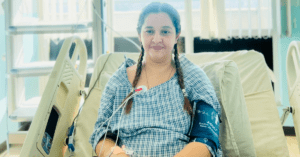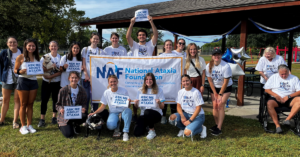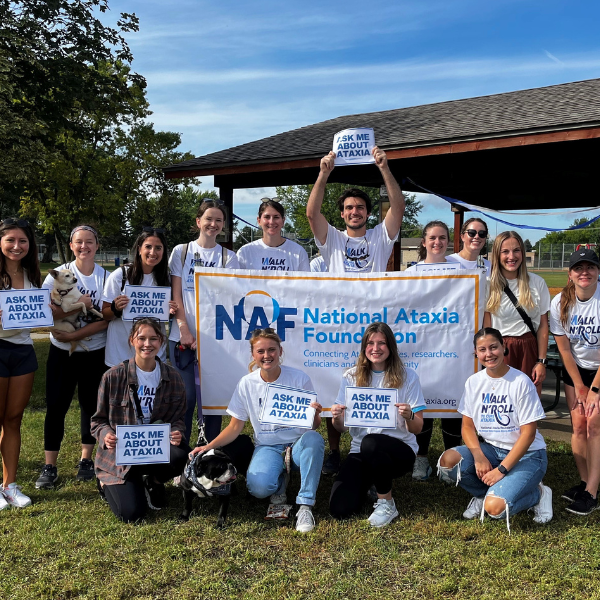
Grief is universal—painful, sticky, and nonlinear. For those navigating chronic illnesses like Ataxia, grief often resurfaces repeatedly, in waves, each time a new change or loss occurs.
This article offers tools, stories, and models for understanding and healing through chronic illness-related grief.
Understanding Grief in Chronic Illness
What Is Grief?
Grief is “deep and poignant distress caused by or as if by bereavement,” according to Merriam-Webster Dictionary. It’s often associated with death, but chronic illness brings “infinite losses”—small, ongoing losses of identity, ability, and future expectations.
Cara Loy, LCSW describes the infinite losses as “losing who you once were, or who your loved one once was.”
The Complexity of Chronic Grief
Megan Marjorie, a writer with chronic illness, captured the experience of chronic grief with great clarity:
“Grief is the could-have-been, the should-have-been, and the may.”
“It’s watching your home fill with medications… It’s the fear of slowing everyone down. The embarrassment of using mobility aids. And wondering—how did I become this person?”
Chronic grief is not confined to a single moment of loss — it lingers, resurfacing as illness changes or milestones pass. It can be triggered by the gradual loss of abilities, shifts in identity, or the strain of adapting to a “new normal” again and again. These emotional wounds are compounded by the unpredictability and progression of illness, often leaving individuals and their loved ones in a cycle of adjustment and mourning for what life once was, and for the futures they imagined
The Grieving Process: It's Not Linear
The classic five stages of grief — denial, anger, bargaining, depression, and acceptance — can be a helpful framework for understanding emotional responses to loss. But in reality, grief rarely follows a neat, step-by-step path. People may revisit the same stage many times, skip others entirely, or experience several at once.
Grief can be contradictory. “You can feel sadness and hope in the same moment. You can laugh and grieve at once,” said Cara Loy, LCSW. It’s common to have moments of joy, connection, or even relief alongside moments of deep pain. This ebb and flow is part of the process, and it doesn’t mean you’re “doing it wrong.”
Check out the webinar on this topic hosted with the help of the Huntington’s Disease Society of America.
The Dual Process Model of Grief
Healing from grief often involves moving back and forth between two different kinds of stressors:
- Loss-Oriented: Grieving what has been lost — whether that’s mobility, independence, or long-held dreams for the future. This is the space where you allow yourself to feel the sadness, anger, or frustration that comes with change.
- Restoration-Oriented: Adapting to a new normal — exploring new hobbies, building fresh routines, or reshaping your sense of identity. This is where growth and adjustment happen, even in the midst of loss.
As one wise reminder from Loy puts it: “Don’t get stuck in the loss. But don’t skip over it either.”
The healthiest grieving allows room for both — honoring what’s gone while still making space for what’s ahead.
Oscillation: The Healthy Back-and-Forth
Much like waves ebbing and flowing, we naturally move between moments of grieving and moments of restoration. This back-and-forth allows us to process loss without being completely consumed by it, giving our hearts and minds time to rest and reset.
It’s the ability to temporarily set grief aside so you can be present for the good in life, then return to it when you have the space and energy to process more deeply. As Loy puts it: “Lay down your grief to enjoy events with family and friends. Pick it back up later.”
This rhythm is not avoidance — it’s a healthy coping pattern that makes it possible to keep living, even in the midst of sorrow.
Emotions and Coping Strategies
The Four Healing Emotions
Grief can stir up a wide range of feelings, and each one carries important information about what we’ve lost. Dr. John Gray identified four healing emotions — each tied to a specific kind of loss or unmet expectation. Understanding these emotions can help us name what we’re feeling and begin to work through it.
Emotion –> What It Explores
- Anger –> What happened that I didn’t want to happen
- Sadness –> What didn’t happen that I wanted to happen
- Fear –> What could happen that I don’t want to happen
- Sorrow –> What can’t happen anymore, even though I wish it could
These emotions are meant to be felt and released—not suppressed.
Coping Strategies Shared by Community Members
The webinar shared above featured individuals coping with chronic illness. They offered up great tips for coping strategies. Here are just a few:
- Creative outlets: Poetry, music, painting, journaling
- Support networks: Therapy, support groups, prayer groups
- Physical release: Yelling, punching pillows, exercise, yoga
- Mindfulness & rest: Meditation, time in nature, mindful distractions
- Small joys: Plan one thing each day that brings you happiness.
Empowerment Through Practical Steps
Living with loss or chronic illness can leave you feeling powerless, but small, intentional actions can help restore a sense of control. While they won’t erase grief or challenges, these steps can make daily life more manageable and create space for emotional healing. They focus on what you can influence.
- Write down questions before appointments
- Control what you can: diet, medication, activity
- Release unnecessary obligations
- Prioritize communication in relationships
- Ask for help.
- Seek professional counseling.
Real Voices, Real Grief
Melissa’s Story – Grieving with Ataxia
A nurse of 20 years, Melissa faced a genetic diagnosis of SCA3 and the painful decision to leave a beloved career. “I had already grieved the loss of what was to come. Disability was the hardest thing I’ve done. But I’m participating in research and helping others. I’m proud of that.”
Melissa experienced layered grief through illness and her father’s passing. “Grief will find me again, but I’ll keep doing what I can.”
What Melissa would say to someone grieving right now? “Faith, family, and friends. Support groups changed my life. You’re not alone. There is life, beauty, and strength on the other side of sorrow.”
Cheryl’s Story – A family’s journey with Huntington’s Disease (HD)
Cheryl has experienced decades of caregiving, from her husband’s diagnosis in 1989 to losing her daughter to juvenile HD. “We could have laid down and died. Instead, we took the high road. We became educators, advocates, and helpers. That’s what helped us cope.”
Cheryl lost both loved ones, yet Cheryl continues to educate and advocate. “Grief never disappears—but neither does love or purpose.”
What Cheryl would say to someone grieving right now? “Talk it out. Don’t hold it inside.”
Growing Around Grief
“You’re never the same. But life can still be meaningful, joyful, and whole—with grief included.” -Dr. Lois Tonkin
“Grief is constantly changing. So are you. Only great love can cause a great loss. But there’s still so much left in life to live for.” -Megan Marjorie
Resources
- National Ataxia Foundation Support Groups
- Webinar: Living with Loss: Navigating Grief and Chronic Illness
- GriefShare
- Find a therapist
- National Suicide Prevention Lifeline: 988
Article Contributors:
- Cara Loy, LCSW, University of Alabama Movement Disorders Clinic
- Melissa Schmittler (Living with SCA3)
- Cheryl Sullivan (Huntington’s Disease Caregiver)
References:
Grieving Chronic Illness and Injury — Infinite Losses. Social Work Today. (2014, July 7). Grieving chronic illness and injury — Infinite losses. Social Work Today. Retrieved from https://www.socialworktoday.com/archive/070714p18.shtml
Grief (n.d.) Merriam-Webster. (n.d.). Grief. Merriam-Webster. Retrieved from https://www.merriam-webster.com/dictionary/grief
The Continuous Grief of Chronic Illness. Global Genes. (n.d.). The continuous grief of chronic illness. Global Genes. Retrieved from https://globalgenes.org/story/the-continuous-grief-of-chronic-illness/
Chronic Illness and Grief. Virant, K. (2023, March 14). Chronic illness and grief. Psychology Today. Retrieved from https://www.psychologytoday.com/us/blog/chronically-me/202303/chronic-illness-and-grief?msockid=017c36de67d7661a3a59235f66d06754
Coping with Chronic Illness. American Psychological Association. (n.d.). Coping with chronic illness: Information for patients and families. American Psychological Association. Retrieved from https://www.apa.org/topics/chronic-illness/coping-diagnosis
Growing Around Grief. Sue Ryder. (n.d.). Growing around grief. Sue Ryder. Retrieved from https://www.sueryder.org/grief-support/about-bereavement-and-grief/growing-around-grief/
Growing Around Grief. Cruse Bereavement Care. (n.d.). Growing around grief. Cruse Bereavement Care. Retrieved from https://www.cruse.org.uk/understanding-grief/effects-of-grief/growing-around-grief/
Kintsugi (Kintsukuroi). Myers, D. (2021, December 14). The art of kintsugi (kintsukuroi): The Japanese philosophy of embracing imperfection. My Modern Met. Retrieved from https://mymodernmet.com/kintsugi-kintsukuroi/
TIPS-MAPP Leader’s Guide, Meeting 4, “Four Healing Emotions”(2013), Adapted from Gray, John, PhD. (1998). New York: Harper Collins.









